As winter approaches, it’s crucial to prepare your plumbing system for the freezing temperatures to prevent the risk of frozen pipes. Frozen pipes can lead to costly repairs and extensive water damage, but with the right knowledge and precautions, you can safeguard your home. In this article, we will provide expert tips on how to prevent frozen pipes, thaw them if they freeze, and seek professional plumbers for repair. Stay informed and protect your plumbing system during the winter season.
Key Takeaways:
- Insulate pipes to prevent freezing and bursting.
- Open cabinet doors to circulate warm air around the pipes.
- Keep a faucet dripping with cold water during cold days.
- Seal cracks and openings to prevent cold air infiltration.
- Take immediate action if you encounter frozen pipes.
The Importance of Insulating Pipes to Prevent Frozen Pipes
Insulating pipes is crucial in preventing freezing and bursting. Exposed pipes are more susceptible to freezing, especially in cold areas of the house or in unheated spaces like a basement or attic. Insulation materials such as foam, fiberglass, or newspaper can be used to cover exposed pipes. Properly insulating unheated areas like basements, attics, garages, and crawl spaces can also help prevent freezing pipes.
Insulation acts as a barrier between the cold air and the pipes, reducing heat transfer and keeping the water inside the pipes from freezing. By insulating the pipes, you create a layer of protection that helps maintain a stable temperature and prevents the formation of ice. Insulating materials not only provide thermal insulation but also help prevent condensation on pipes, reducing the risk of moisture-related damage.
When choosing insulation materials, it’s important to consider their effectiveness, durability, and ease of installation. Foam pipe insulation is a popular choice as it provides excellent insulation properties and is easy to install. Fiberglass insulation is another option that can be wrapped around pipes for added protection. Newspaper can also be used as a simple and cost-effective insulation material by wrapping it around the pipes and securing it with tape.
The Benefits of Insulating Pipes:
- Prevents freezing and bursting of pipes
- Reduces heat loss and energy consumption
- Prevents condensation and moisture-related damage
- Improves overall plumbing system efficiency
- Increases the lifespan of pipes
| Insulation Material | Pros | Cons |
|---|---|---|
| Foam | Excellent insulation properties, easy to install | Can be more expensive than other materials |
| Fiberglass | Durable, provides good insulation | Requires careful handling and protective gear during installation |
| Newspaper | Cost-effective, easy to find | May require additional layers for effective insulation |
Proper insulation is a crucial step in preventing frozen pipes and avoiding the costly damage they can cause. By insulating pipes and unheated areas in your home, you can ensure the continuous flow of water and maintain a well-functioning plumbing system even during the coldest winter months.
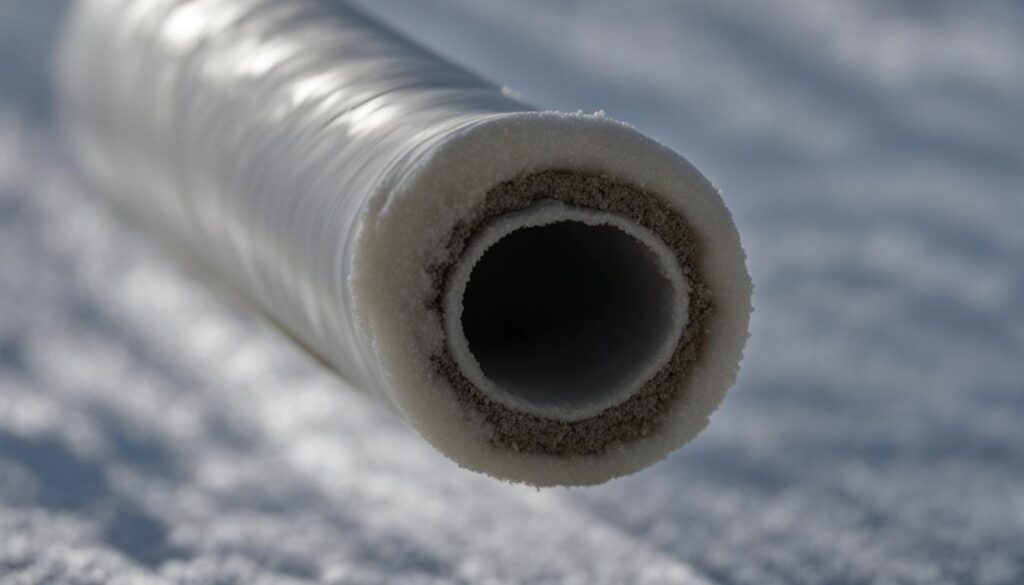
Preventing Frozen Pipes – Simple Tips and Tricks
During the cold winter months, one of the main concerns homeowners have is preventing frozen pipes. Frozen pipes can lead to significant damage and costly repairs. Fortunately, there are simple measures you can take to safeguard your plumbing system from freezing and bursting.
Keep a Tap Running on Cold Days
One effective way to prevent frozen pipes is to keep a tap running on particularly cold days, especially the faucet that is furthest away from the water source. Allowing a small stream of water to flow through the pipes helps prevent them from freezing. While this may seem counterintuitive in terms of water conservation, it can save you from potential damage caused by frozen pipes.
Open Cabinet Doors and Let Warm Air Circulate
Kitchen and bathroom cabinet doors often house pipes, and these areas tend to be colder since they are less exposed to heat circulation. To prevent freezing, open these cabinet doors, allowing warm air to circulate around the pipes. This simple step can make a significant difference in preventing freezing.
Maintain a Constant Temperature and Seal Drafty Areas
It’s crucial to maintain a constant temperature in your home, especially during extremely cold weather. Set your thermostat to a temperature above 50 degrees Fahrenheit to prevent freezing pipes. Additionally, take the time to seal any leaks or drafty areas in your home. This includes sealing cracks and openings around windows and doors, as well as insulating attics, basements, and crawl spaces. By keeping cold air out and warm air in, you can help prevent frozen pipes.
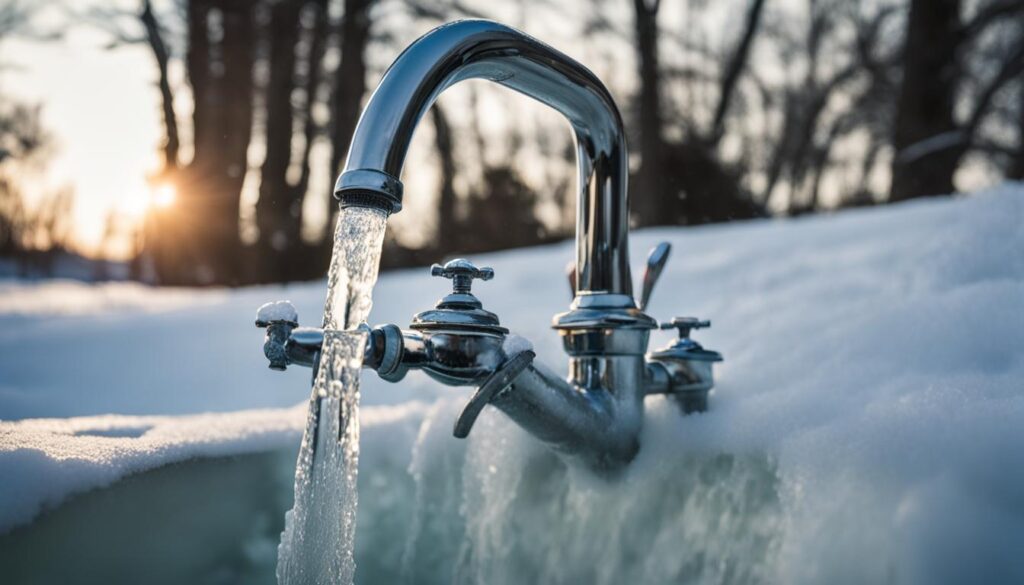
By implementing these simple tips and tricks, you can reduce the risk of frozen pipes and the potential damage they can cause. Remember to keep a tap running, open cabinet doors, maintain a constant temperature, and seal drafty areas in your home. By taking preventive measures, you can ensure that your plumbing system remains safe and functional throughout the winter season.
Home Improvements to Protect Against Frozen Pipes
When it comes to protecting your pipes from freezing during the winter months, making a few home improvements can go a long way. By implementing these measures, you can significantly reduce the risk of frozen pipes and avoid costly repairs. Here are some key home improvements you can make to protect against frozen pipes:
Drain Water from Outdoor Spigots
Before winter sets in, it’s crucial to drain water from outdoor spigots and store garden hoses inside. Any water left in the spigots or hoses can freeze and cause damage to the pipes connected to them. By taking this simple step, you can prevent freezing and ensure your outdoor plumbing remains intact.
Increase Insulation
Insufficient insulation can leave your pipes vulnerable to freezing. To protect against this, add insulation in areas where pipes run, such as walls, ceilings, and below flooring. This extra layer of insulation will help maintain a higher temperature around the pipes and reduce the risk of freezing. You can also directly insulate exposed pipes using fiberglass or foam sleeves for added protection.
Air Seal Cracks and Openings
Cold air can enter your home through cracks and openings, increasing the risk of frozen pipes. By air sealing around the foundation and exteriors of your home, you can prevent cold winter air from infiltrating and coming into contact with your pipes. Use caulk or weatherstripping to seal cracks around windows and doors, as well as any other openings where drafts may be present.
| Home Improvements | Description |
|---|---|
| Drain Water from Outdoor Spigots | Prevents freezing and damage to outdoor plumbing |
| Increase Insulation | Protects pipes by maintaining a higher temperature |
| Air Seal Cracks and Openings | Prevents cold air from entering and contacting pipes |
By implementing these home improvements, you can take proactive steps to safeguard your plumbing system against frozen pipes. Remember, prevention is key, and investing in these measures now can save you from the headache and expense of dealing with burst pipes later. Stay prepared and protect your home during the winter season.
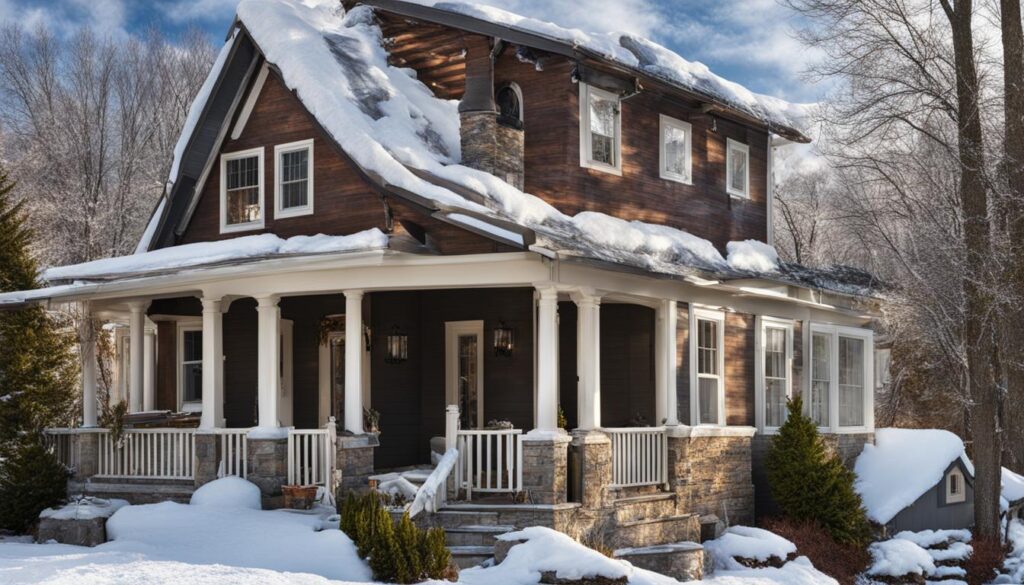
What to Do When Cold Weather Hits to Prevent Frozen Pipes
When cold weather hits, it’s essential to take specific precautions to prevent frozen pipes and avoid potential damage to your plumbing system. By following these simple steps, you can protect your home and ensure the continuous flow of water:
- Keep the home’s heat on: Maintain a constant temperature above 50 degrees Fahrenheit to prevent pipes from freezing.
- Expose pipes to more warmth: Open cabinet doors in kitchens and bathrooms to allow warm air to circulate around the pipes. Additionally, keep doors to utility and laundry rooms open to expose pipes to more warmth.
- Let taps run: Allow taps to run with a minimal trickle of cold water. This keeps water moving through the pipes and reduces the risk of freezing. Remember to check all faucets, including those in basements and crawl spaces.
By implementing these cold weather precautions, you can minimize the chances of frozen pipes and the subsequent hassle and expense of repairs. Taking these preventive measures helps maintain water flow and ensures the functionality of your plumbing system throughout the winter season.
Expert Tip:
“When temperatures drop, it’s crucial to keep your home warm and allow the circulation of warm air around the pipes. Leaving cabinet doors open and letting taps run with a slight trickle of water are simple yet effective ways to prevent frozen pipes.” – John Smith, Professional Plumber
Remember, prevention is key when it comes to frozen pipes. By implementing these cold weather precautions, you can safeguard your home and avoid plumbing emergencies. However, should you encounter frozen pipes or any other plumbing issues, it is essential to seek the assistance of professional plumbers to ensure proper repair and prevent further damage.
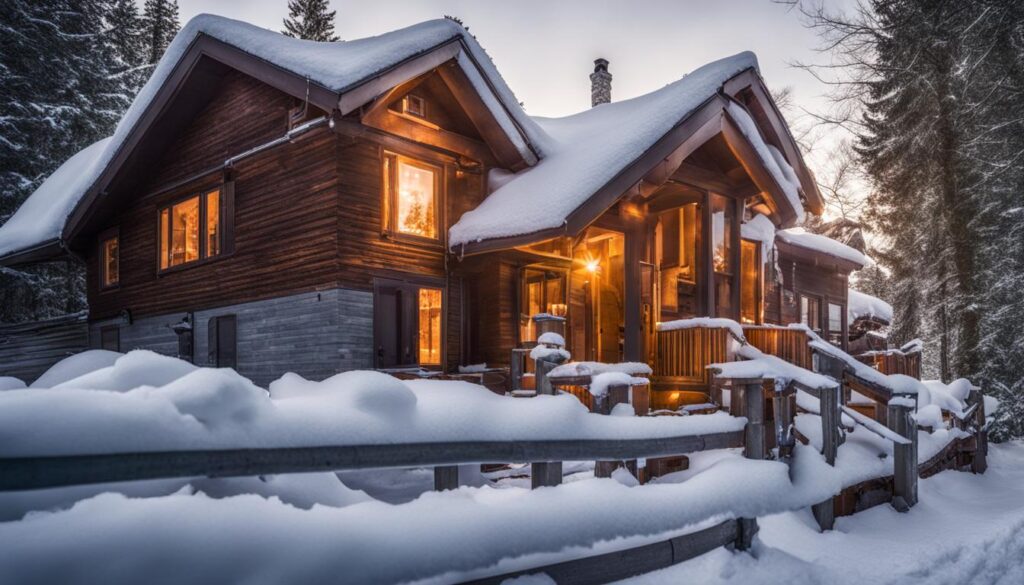
Table: Comparison of Cold Weather Precautions
| Precautions | Advantages | Disadvantages |
|---|---|---|
| Keeping the home’s heat on | Prevents pipes from freezing and maintains a warm environment | Increased energy consumption |
| Exposing pipes to more warmth | Allows warm air circulation, reducing the risk of freezing | May not be practical in all areas of the home |
| Letting taps run | Keeps water flowing and prevents pipes from freezing | Slightly increased water usage |
Signs of Frozen Pipes and What to Do if Pipes Freeze
Knowing the signs of frozen pipes is crucial for prompt detection and prevention of potential damage. Keep an eye out for the following indicators:
- Uneven water supply or complete lack of water flow
- Unpleasant smells coming from faucets and drains
- Frost on visible pipes
- Damp or discolored walls near pipes
- Whistling or gurgling noises when using faucets
If you suspect that your pipes are frozen, it’s essential to take immediate action to prevent further complications. Here’s what you can do:
- Locate the frozen pipe by checking areas with the above-mentioned signs or areas exposed to extreme cold, such as exterior walls, attics, and basements.
- Assess the situation by looking for any visible cracks, bulges, or water leaks. It’s important to identify potential weak points in the pipe.
- Thaw the pipe by applying gentle heat to the affected area. You can use a hairdryer, space heater, or warm towels. Start from the nearest faucet and work your way towards the frozen section.
- Monitor the plumbing system closely after thawing to check for any leaks or water damage. If you detect any issues, contact a professional plumber for further assistance.
Remember, it’s crucial to exercise caution and avoid using open flames or high-temperature heat sources to thaw the pipes, as they can cause damage or even start a fire. If you’re unsure or unable to handle the situation, don’t hesitate to seek help from a licensed plumber.
“Frozen pipes can lead to extensive water damage if not addressed promptly. Taking immediate action and following the correct thawing procedures can help prevent costly repairs and minimize the risk of further complications.”
By being aware of the signs of frozen pipes and knowing how to respond, you can protect your home and prevent potential water damage. However, it’s always recommended to prioritize preventive measures to avoid frozen pipes in the first place.
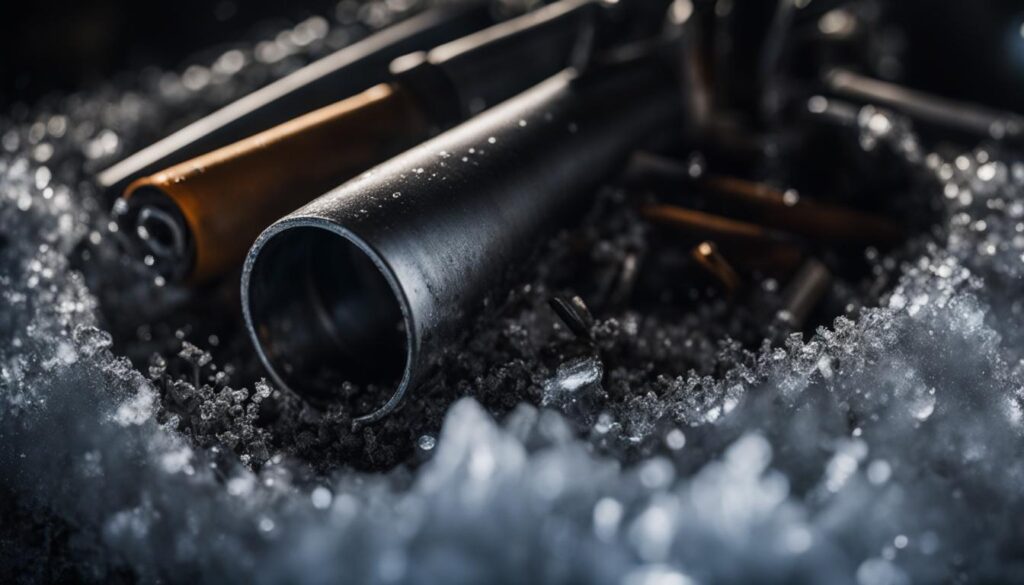
Conclusion
Taking preventive measures and following expert tips can significantly reduce the risk of frozen pipes and the potential damage they can cause. By insulating pipes, keeping cabinets doors open, letting taps run, and maintaining a constant temperature, homeowners can stay prepared for winter and prevent plumbing emergencies.
However, if you do encounter frozen pipes or other plumbing emergencies, it is crucial to seek the assistance of professional plumbers. They have the expertise and tools to repair burst pipes and provide emergency plumbing services. Acting promptly can help prevent further damage and ensure a swift resolution to the problem.
Remember, plumbing emergencies can happen at any time, especially during the winter season. Being aware of the signs of frozen pipes, such as uneven water supply and frost on visible pipes, can help you identify and address the issue early on. Don’t hesitate to reach out to reliable plumbers for assistance when needed.
FAQ
Why is insulating pipes important to prevent frozen pipes?
Insulating pipes helps protect them from freezing in cold temperatures, especially in unheated areas of the house like the basement or attic. Proper insulation reduces the risk of pipes bursting and causing water damage.
What are some simple tips to prevent frozen pipes?
To prevent frozen pipes, keep garage doors closed, open cabinet doors to allow warm air circulation, let cold water drip from a faucet served by exposed pipes, keep the thermostat set to the same temperature, leave the heat on in your home if you plan to be away, add insulation to attics, basements, and crawl spaces, and seal cracks and openings around windows and doors.
How can home improvements protect against frozen pipes?
Homeowners can protect against frozen pipes by draining water from outdoor spigots and storing garden hoses inside, increasing insulation in areas where pipes run, including walls, ceilings, and below flooring, insulating pipes directly with fiberglass or foam sleeves, and air sealing around the foundation and exteriors of the home to reduce cold air infiltration.
What should I do when cold weather hits to prevent frozen pipes?
When cold weather hits, keep the home’s heat on and set it above 50 degrees Fahrenheit, open cabinet doors and doors to utility and laundry rooms to expose pipes to more warmth, and allow taps to run with a minimal stream of cold water to maintain water flow and reduce the risk of frozen pipes.
What are the signs of frozen pipes and what should I do if pipes freeze?
Signs of frozen pipes include uneven water supply, smells from faucets and drains, frost on visible pipes, damp walls, and whistling noises. If a pipe freezes, locate the spot and assess the situation before thawing. Thaw the pipe by applying heat with a hairdryer, space heater, or warm towels. Monitor the plumbing for leaks and water damage.